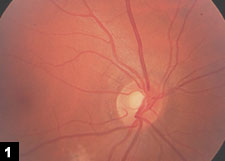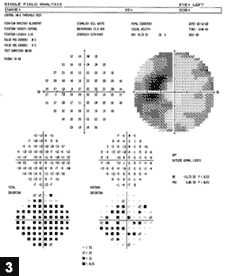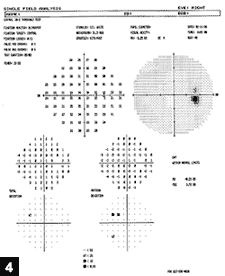Man presents with small cloudy area near center of vision in left eye
A relative afferent pupillary defect was found in the left eye; rare cells were seen in the anterior chamber and anterior vitreous.
![Grand Rounds at the New England Eye Center [logo]](/~/media/images/news/print/ocular-surgery-news/2006/07_july_1/grandroundslogo_200_76_17519.gif)
A 40-year-old man with no significant medical history went to his ophthalmologist complaining of blurry vision in the left eye. The symptoms began while the patient was at rest, watching TV. He experienced slight discomfort but no pain. He did not feel the vision changes were serious and felt that his condition would improve after a night of rest. The next day, the patient noticed a gray, cloudy, circular area slightly above the center of his vision in the left eye. He denied any double vision, light flashes or new floaters. The spot was not accompanied with pain, and this was the first episode of these symptoms.
![Jane Loman, MD [photo]](/~/media/images/news/print/ocular-surgery-news/2006/05_may_15/loman_70_90_16845.jpg) Jane Loman | ![Zinaria Williams, MD [photo]](/~/media/images/news/print/ocular-surgery-news/2006/05_may_15/williams_70_90_16845.jpg) Zinaria Williams |
After additional questioning, the patient reported a vague history of irritated, red eyes with an itchy and gritty sensation over the past 2 months. In addition, he had a left lazy eye that was diagnosed when he was 9 years old. The left eye has always been slightly weaker than the right; however, the current symptoms were a definite change from baseline. He was wearing glasses to correct myopia.
He denied any other neurologic symptoms, and the remainder of the review of systems was negative. He was not allergic to any medications and was taking an oral nonsteroidal anti-inflammatory for knee pain.
Examination
On examination, visual acuity was 20/20 in the right eye and 20/80 in the left. There was a prominent relative afferent pupillary defect in the left eye. The pupil was normal in the right. The patient saw all AOHRR color plates (6/6) in the right eye but missed the first four with the left eye. No ptosis was present, and exophthalmometry was normal. Extraocular motility was full bilaterally, and both eyes were normally aligned and conjugate.
IOP was 17 mm Hg in the right eye and 18 mm Hg in the left eye by applanation. The left eye demonstrated slight conjunctival injection in comparison to the right eye, and rare follicles were seen on the left palpebral conjunctiva. The corneas were clear bilaterally. Rare cells were seen in the anterior chamber of the left eye. The remainder of the anterior segment examination was normal.
Dilated fundus examination was normal in the right eye (Figure 1) but showed significant optic disc edema with several flame-shaped hemorrhages extending from the nerve in the left eye (Figure 2). Scattered patches of exudates were also observed extending in a radial pattern from the macula. The media was slightly hazy with rare cells visible in the anterior vitreous.
Humphrey automated visual fields (30-2) revealed a markedly enlarged blind spot in the left eye, worse superiorly (Figure 3). Visual field analysis in the right eye was normal (Figure 4).
|
|
|
|
|
Images: Chin V, Hedges T |

What is your diagnosis?
Relative afferent pupillary defect
The findings of a relative afferent pupillary defect, loss of color vision and paracentral visual field findings indicate an optic neuropathy. This was associated with a stellate pattern of exudation in the macula.
Since the presentation is acute and the patient is young, infectious causes of optic neuropathy, such as tuberculosis, syphilis and Lyme disease, should be considered. Inflammatory causes, such as vasculitis or sarcoid, are possible. An anterior ischemic optic neuropathy would also be in the differential, although improbable based on the lack of medical history.
While important to rule out the many sources of optic neuropathy, this specific pattern of fundus findings in this patient is highly suggestive of Leber’s idiopathic stellate neuroretinitis.
Discussion
Neuroretinitis refers to specific ophthalmic manifestations of cat scratch disease, which is a generally benign and self-limited illness caused by the gram-negative bacillus Bartonella henselae. The disease has many manifestations but usually causes a systemic febrile disease with regional lymphadenopathy. Cats are the primary mammalian reservoir of the infectious bacteria and are asymptomatic. Transmission occurs by direct inoculation into open wounds or mucous membranes.
Ophthalmic features of the disease include Parinaud’s oculoglandular syndrome and neuroretinitis. Parinaud’s oculoglandular syndrome is the most common ocular complication and presents as a serous conjunctivitis, often associated with granulomatous nodules on the conjunctiva. Neuroretinitis is most commonly used to describe optic disc edema with an associated peripapillary or macular star composed of lipid exudates. Other terms that have been used previously include Leber’s idiopathic stellate retinopathy or Leber’s neuroretinitis.
Approximately 22,000 cases of cat scratch disease occur annually in the United States. About 2% to 5% manifest in Parinaud’s oculoglandular syndrome, while the incidence of neuroretinitis is much less common, although the exact prevalence remains unknown.
Among patients who develop neuroretinitis, about two-thirds show evidence of previous B. henselae infection on serologic testing.
Neuroretinitis is usually a unilateral finding, although patients with bilateral optic disc swelling and macular star formation have been reported. Optic disc edema is often accompanied by peripapillary subretinal fluid and usually predates the formation of a macular star by 2 to 4 weeks. Clinically, the papillitis produces an afferent pupillary defect along with central or cecocentral scotomas on visual field testing and color vision difficulties. Fluorescein angiography demonstrates leakage of optic disc vessels with late disc staining.
Most patients also demonstrate mild anterior or posterior segment inflammation. Choroidal inflammation is possible as well, with patchy choroidal phase filling and multiple areas of hyperfluorescent choroidal leakage. The stellate exudates of the macular star are highly variable. Some patients with cat scratch disease will develop optic neuropathy without formation of a macular star. Other patients develop massive disc swelling with widespread subretinal and intraretinal exudates. The star may take months to resolve.
The diagnosis of Leber’s neuroretinitis is primarily based on clinical history with previous exposure to cats. Serologic testing is helpful to demonstrate exposure to the bacterial antigens but is not completely specific to B. henselae species. High titer results may indicate recent or current infection, with IgG positivity suggestive of current or past infection and IgM titers suggestive of more recent or active infection. Polymerase chain reaction is not generally available, but assays have been developed that differentiate between various Bartonella species. A complete blood count is nonspecific, but it may show eosinophilia and minimal leukocytosis, and erythrocyte sedimentation rates may be elevated during the first 2 weeks.
Cat scratch disease is generally self-limited and has a benign disease course. Consequently, treatment is usually supportive in immunocompetent individuals. However, in immunocompromised patients and patients with significant ocular involvement, antibiotic therapy is indicated. B. henselae is generally sensitive to many antibiotics including ciprofloxacin, Bactrim (sulfamethoxazole and trimethoprim), gentamicin and tetracycline. However, some literature suggests doxycycline may have better ocular penetration and a lower side effect profile.
Patient course
Extensive laboratory tests were performed; they were all normal except for a positive IgG titers for B. Henselae. The patient was placed on doxycycline for 3 weeks and experienced a gradual visual recovery over the next 2 months.
For more information:
- Victor Chin, MD, and Thomas Hedges III, MD, can be reached at New England Eye Center, Tufts University School of Medicine, 750 Washington St., Box 450, Boston, MA 02111; 617-636-4219; fax: 617-636-4866; Web site: www.neec.com.
- Edited by Jane Loman, MD, and Zinaria Williams, MD. Drs. Loman and Williams can be reached at New England Eye Center, Tufts University School of Medicine, 750 Washington St., Box 450, Boston, MA 02111; 617-636-4219; fax: 617-636-4866; Web site: www.neec.com. Drs. Loman and Williams have no direct financial interest in the products mentioned in this article, nor are they paid consultants for any companies mentioned.
References:
- Bass JW, Freitas BC, et al. Prospective randomized double blind placebo-controlled evaluation of azithromycin for treatment of cat-scratch disease. Pediatr Infect Dis J. 1998;17(11):1059-1061.
- Bogue CW, Wise JD, Gray GF, Edwards KM. Antibiotic therapy for cat-scratch disease? JAMA. 1989;262(6):813-816.
- Carithers HA, Margileth AM. Cat-scratch disease. Acute encephalopathy and other neurologic manifestations. Am J Dis Child. 1991;145(1):98-101.
- Cunningham ET, Koehler JE. Ocular bartonellosis.Am J Ophthalmol. 2000;130(3):340-349.
- Francois J, Verriest G, De Laey JJ. Leber’s idiopathic stellate retinopathy. Am J Ophthalmol. 1969;68(2):340-345.
- Greer WE, Keefer CS. Cat-scratch fever; a disease entity. N Engl J Med. 1951;244(15):545-548.
- Holley HP. Successful treatment of cat-scratch disease with ciprofloxacin. JAMA. 1991;265(12):1563-1565.
- Margileth AM. Cat-scratch disease: current concepts. Hosp Med. 1985;57-93.
- Margileth AM. Antibiotic therapy for cat-scratch disease: clinical study of therapeutic outcome in 268 patients and a review of the literature. Pediatr Infect Dis J. 1992;11(6):474-478.
- Rost Monahan S. Neuroretinitis: a clinical syndrome of cat-scratch disease. Clin. Eye Vis. Care. 2000;12(3-4):155-159.
- Shinall EA. Cat-scratch disease: a review of the literature. Pediatr Dermatol. 1990;7(1):11-18.
- Zangwill KM, Hamilton DH, et al. Cat scratch disease in Connecticut. Epidemiology, risk factors, and evaluation of a new diagnostic test. N Engl J Med. 1993;329(1):8-13.













